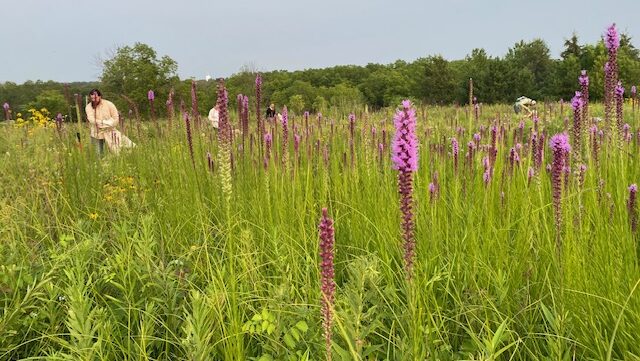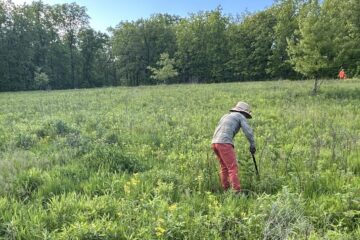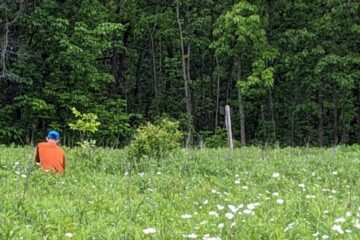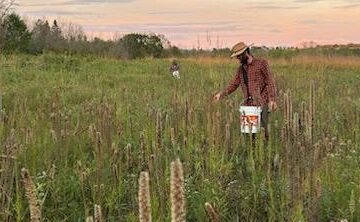David Laufenberg from Adaptive Restoration, LLC presented an update on the Blue Mound State Park prairie restoration project at a recent event. We are thankful for David’s expertise and for the work volunteers have provided during the scope of this project. Below is David’s update.
You can help maintain the prairies by participating in ongoing work parties. Learn more…
The Prairies in the park were burned mid-spring. The Adaptive Restoration crew sprayed Swain and upper Walnut Prairies about one month post-fire for crown vetch, spotted knapweed, reed canary grass, brush re-sprouts, and sumac. Adaptive Restoration then returned to predate biennial weeds, wild parsnip, and sweet clover.
There have been two volunteer events so far in 2025. In May volunteers worked alongside Adaptive Restoration to interseed native seed into areas that had been sprayed in the past and predated biennial weeds at Swain. In June volunteers interseeded native seed into areas that had been sprayed in the past and predated biennial weeds at Upper Walnut. Sprayed areas often have some degree of “friendly fire” so it is best practice to return and seed those areas with natives. The seeds used were collected by Friends volunteers in the Fall of 2024.

Both prairies have experienced significant benefits following 1.5 years of directed restoration management.
Swain Prairie
- Swain Prairie’s main issue continues to be crown vetch. David noted that patches are now retreating instead of growing, a 90% reduction. The final 10% is the hardest to eradicate, but perhaps most important, given it will return to pre-treatment levels within a few years if there’s a lack of management
- Reed canary grass is still present, but also much reduced – mostly near the Swain Prairie sign at the north end of the prairie.
- Sweet clover is present, but 95% reduced, and no seed is likely to be produced this year.
- Ragweed is much less profuse near the camping sites this year. Long-term, they do not tend to be an issue for prairies, but in the short term, they can shade out native plants. They were mowed last year to prevent this from happening.
- Native plants are flourishing and cover 95% of the land. Native thistle and purple milkweed, which are state-endangered, can be seen.
Upper Walnut Prairie
- Last year’s work on a handful of mature walnuts and woody plants along the south and south east perimeter have opened up this prairie in a significant way. It has also lent to more weed expression in these zones. Spotted knapweed, brush sprouts, sumac, and elderberry is returning but much reduced. These are native plants, but can over take an area and reduce biodiversity if there’s a legacy of a lack of disturbance. Underlying geology lends to seepages/sinkholes that favor these species, so they are likely to return/thrive in these areas.
- Sweet clover remains the main weed of concern in this prairie. Almost no seed production will occur this year following three sessions of mechanical mowing/predating. Small amounts of birdsfoot trefoil and crown vetch are present, but retreating due to management. Poison ivy exists in high numbers, so beware if working or playing in this prairie
- Wild parsnip is present, but largely reduced since last season.
- Native species are flourishing with 95% of land cover. Highlights include blazing star, gentian, and Ohio spiderwort.


